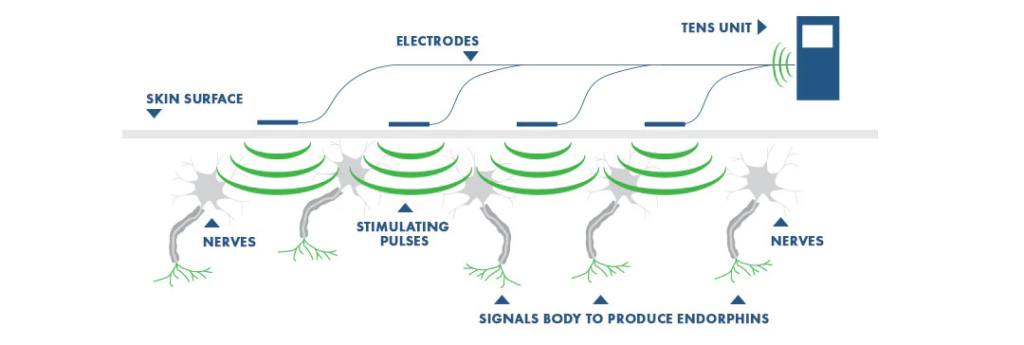
Transcutaneous Electrical Nerve Stimulation (TENS) units are devices used for pain management and relief. These devices deliver small electrical impulses through electrodes placed on the skin. Here’s a detailed explanation of how TENS units work:
Mechanism of Action
- Electrical Impulses: TENS units generate low-voltage electrical currents that are delivered to the body via electrodes placed on the skin.
- Nerve Stimulation: The electrical impulses stimulate sensory nerves, creating a tingling sensation.
- Pain Signal Interruption: These impulses help to block or reduce the transmission of pain signals to the spinal cord and brain, which can alleviate the sensation of pain.
- Endorphin Release: TENS therapy can also trigger the release of endorphins, which are natural painkillers produced by the body. This further helps in reducing pain.
Scientific Basis
- Gate Control Theory: This is one of the primary theories explaining how TENS works. According to this theory, non-painful input (like the electrical impulses from a TENS unit) closes the “gates” to painful input, preventing the pain sensation from traveling to the central nervous system. This mechanism essentially “distracts” the brain from perceiving pain.
- Endorphin Release: Another mechanism is the stimulation of endogenous opioid systems. The electrical stimulation can lead to the release of endorphins, which bind to opioid receptors in the brain to reduce pain perception.
Components of a TENS Unit
- Electrodes: Pads placed on the skin that deliver electrical impulses to the body.
- Lead Wires: Connect the electrodes to the TENS unit.
- TENS Unit: The main device that generates and controls the electrical impulses. It typically includes settings for adjusting the intensity, frequency, and duration of the electrical stimulation.
Settings and Adjustments
- Intensity: The strength of the electrical impulses can be adjusted to suit the user’s comfort level and pain relief needs.
- Frequency: This refers to the number of electrical pulses delivered per second. Low-frequency TENS (1-20 Hz) is often used for muscle stimulation and endorphin release, while high-frequency TENS (50-150 Hz) is used for pain blocking.
- Duration: The length of each pulse can also be adjusted. Longer pulse durations are typically used for deeper nerve stimulation.
Usage and Application
- Placement: Electrodes should be placed around the pain area, following specific patterns depending on the pain condition.
- Session Length: Typical sessions can last from 15 minutes to an hour, and multiple sessions can be conducted throughout the day if needed.
